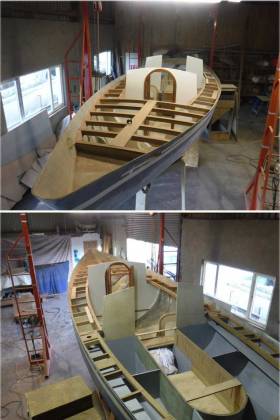Displaying items by tag: Alchemy Marine
Alchemy’s Irish Classic Boat Magic is Being Worked Again
When Bill Trafford chose the business name Alchemy Marine for his extremely individualistic combination of skills in transforming vintage fibreglass hulls into a new take on classic designs of yesteryear, he made the perfect brand-name choice writes W M Nixon.
In his hidden workshop near Skenakilla Crossroads in the depths of very rural North County Cork somewhere west of Mitchelstown, Bill creates something which really is beyond magic. It’s beyond magic because, while it may seem well into the realms of fantasy, the outcome is practical, seaworthy and elegant craft that sail swiftly and can take their place with pride in the most stylish company. They look at home in any anchorage and particularly in a beautiful Irish natural harbour, where the setting and the boat complement each other.
Having in recent years transformed an Elizabethan 23 and an Etchells 22, Bill is now working his considerable talents in meeting a very special request from a client who seeks a glassfibre-hulled version re-creating the spirit of the Alan Buchanan-designed Colleen.
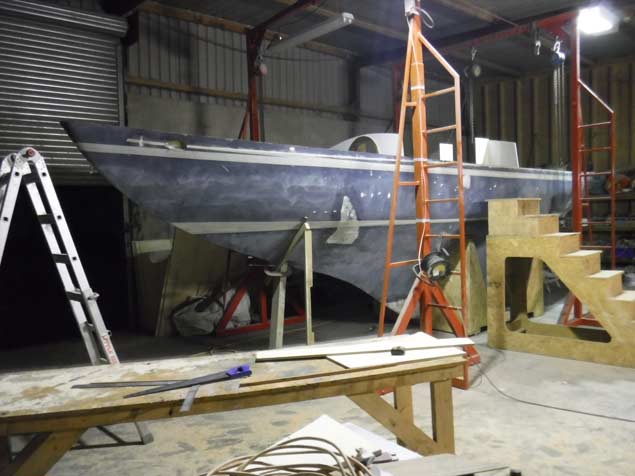 When this photo was taken, it was still possible to see traces of the original Elizabethan 29, but as the work progresses, she becomes a classic Colleen.
When this photo was taken, it was still possible to see traces of the original Elizabethan 29, but as the work progresses, she becomes a classic Colleen.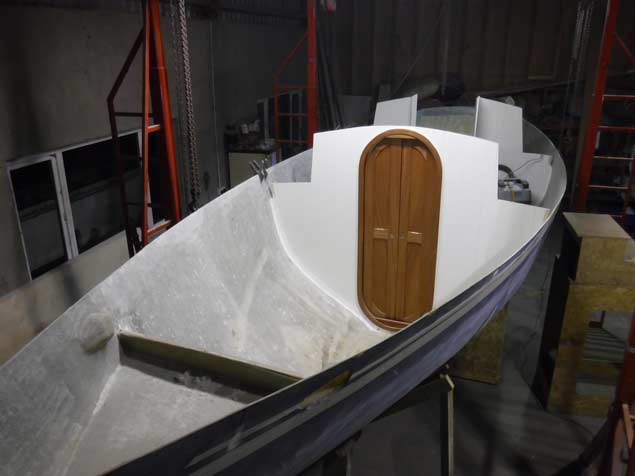 From the earliest stages, the highest standards of boat-building skill have been allied with an experienced eye to assess what is possible.
From the earliest stages, the highest standards of boat-building skill have been allied with an experienced eye to assess what is possible.
 The new transom stern now looks to be part of the boat
The new transom stern now looks to be part of the boat
At least three of these pretty 24ft transom-sterned sloops were wooden-built by John Thuillier of Kinsale in 1950. However, finding an old but well-built fibreglass hull which could be transformed into something with that unmistakable Buchanan look required more than a little lateral thinking. But Bill did a spot of brooding, and once again came up with the solution.
The Elizabethan 29 was designed by Kim Holman in 1960 and series-built by Peter Webster in GRP at Lymington. A pretty boat, she was a race winner in her day. But as she has quite a long counter and the complete early-Holman look, most of us wouldn’t see a Buchanan Colleen anywhere in there at all.
 Before and after. The Elizabethan 29 (above) looked like this before becoming the “donor hull” to provide the basis for a reborn Colleen (below)
Before and after. The Elizabethan 29 (above) looked like this before becoming the “donor hull” to provide the basis for a reborn Colleen (below)
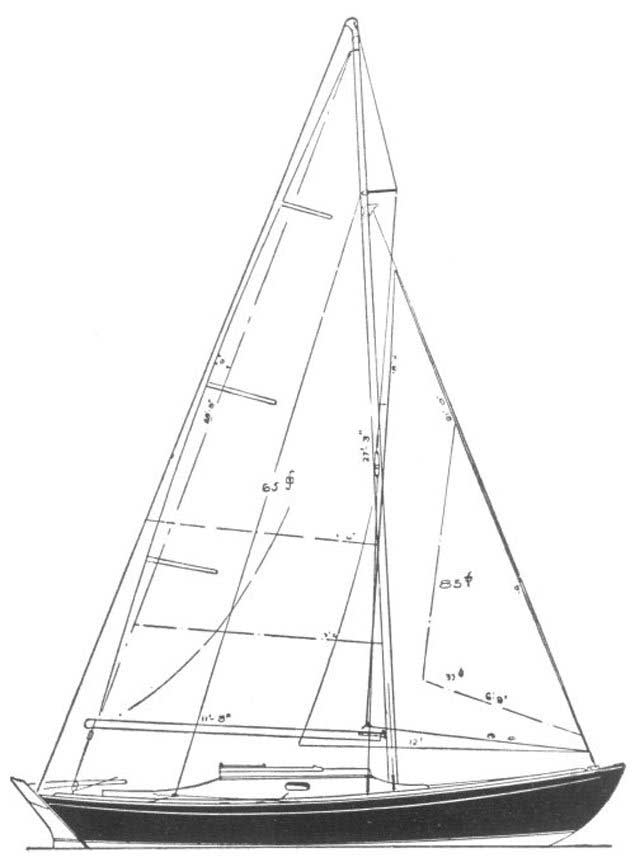 But Bill Trafford saw the Elizabethan 29 as his “donor hull”. And now the transformation is proceeding apace at Skenakilla. The counter has gone, and there’s a new transom stern in place. With all the old GRP deck and coachroof long since removed, the sheerline has been given a completely new tweak to give her that authentic Buchanan look, and soon one of Bills peerless teak-laid decks will be in place, with a new coachroof to match.
But Bill Trafford saw the Elizabethan 29 as his “donor hull”. And now the transformation is proceeding apace at Skenakilla. The counter has gone, and there’s a new transom stern in place. With all the old GRP deck and coachroof long since removed, the sheerline has been given a completely new tweak to give her that authentic Buchanan look, and soon one of Bills peerless teak-laid decks will be in place, with a new coachroof to match.
As ever with Alchemy Marine, it’s all in a league of its own. The workmanship is invariably of top craftsmanship level, and all Bill’s skills as a highly-trained boatbuilder working in many materials are much in evidence. In an ideal world, it might be happening somewhere near a sailing centre that would make it all slightly more accessible for classic boat enthusiasts. But in fact, for true devotees, this is something that merits a pilgrimage.
 Classic craftsmanship. Bill Trafford’s award-winning transformation two years ago with this Elizabethan 23 indicates the standard being achieved with the re-born Colleen.
Classic craftsmanship. Bill Trafford’s award-winning transformation two years ago with this Elizabethan 23 indicates the standard being achieved with the re-born Colleen.
Alchemy Marine Will Work Magic to Re–Create Cork Harbour Classic Boat of 65 Years Ago
Bill Trafford of Alchemy Marine, hidden away in the farmland of Skenakilla west of Mitchellstown in north County Cork, has carved himself a unique reputation in recent years for successfully re-imagining glassfibre boats of a certain age, and transforming them into modern classics writes W M Nixon.
In fact, calling them “boats” at a key stage of this process is scarcely accurate. What arrives in his shed as a former but still recognisably standard sailing craft quickly becomes no more than “the donor boat”, which is soon a bare hull with which Bill is free to play, re-tweaking the sheerline, altering the stern, and adding a completely new deck and coachroof configuration
That’s just for starters. But with the former Elizabethan 23 Kioni, and more recently the former Etchells 22 Guapa, the process is indeed magic, because both boats have ultimately emerged as beautiful head-turners wherever they sail.
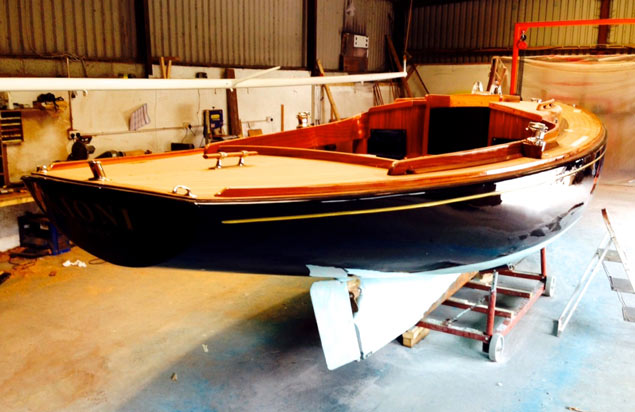 The beautiful Kioni was created from a lengthened Elizabethan 23 glassfibre hull. But now Bill Trafford plans to re-create the spirit of the Colleen by shortening an Elizabethan 29 hull
The beautiful Kioni was created from a lengthened Elizabethan 23 glassfibre hull. But now Bill Trafford plans to re-create the spirit of the Colleen by shortening an Elizabethan 29 hull
But while he was given a lot of freedom in making choices with those boats, Bill’s main project this winter is for a very specific project.
Back in 1950, some members of the Royal Cork YC commissioned a boat from up-and-coming yacht designer Alan Buchanan. They wanted a miniature yet classically stylish performance cruiser, just 23ft 2ins LOA, to be called the Colleen and capable of being built locally.
The 1950s were very far from being a boom time in Ireland, so it seems that no more than four were built. But one or two are still about, and a contemporary Cork Harbour sailor fancies the look of them, but doesn’t fancy the hassle of maintaining a wooden hull.
So now Bill Trafford faces the challenge of creating a new Colleen from a glassfibre hull donated by some other boat. He quickly realised that the Buchanan-designed glassfibre Halcyon 27 – which has a transom stern – was otherwise unsuitable, so he settled on the Elizabethan 29, designed by Kim Holman and built with great success by Peter Webster in Lymington in the 1950s.
 The original Colleen profile. While the spirit of the boat will be re-captured, it’s possible the very vigorous sheerling will be slightly softened by moving the lowest point a little bit further aft
The original Colleen profile. While the spirit of the boat will be re-captured, it’s possible the very vigorous sheerling will be slightly softened by moving the lowest point a little bit further aft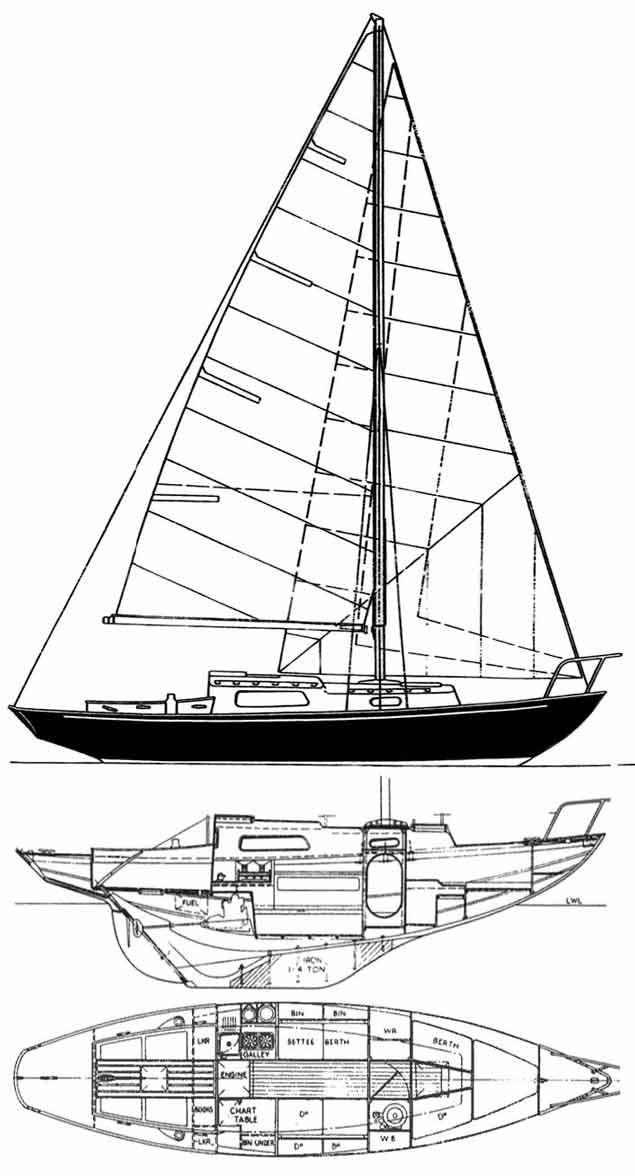 The Elizabethan 29 in unaltered form – it takes Bill Trafford’s vision to see a Colleen in there somewhere
The Elizabethan 29 in unaltered form – it takes Bill Trafford’s vision to see a Colleen in there somewhere
He found one in giveaway terms on ebay in the middle of England at Milton Keynes, and Jonathan Kennedy of Kennedy Boat Haulage personally undertook the long trek to move the little boat from a neglected condition in the middle of England to a winter of transformation in the middle of Munster.
Having seen what Bill Trafford has been able to do with a former Elizabethan 23 and a former Etchells 22, there’s no need to doubt that the spirit of the Colleen will be re-captured in that secret laboratory near Skenakilla Cross-roads. And those of us who feel that the vigorous sheerline of the original might have been better if it had the lowest point slightly further aft may even be indulged in our views. But that of course is up to the owner, who has greatly brightened the prospects of the winter by commissioning this fascinating project
 The donor hull of the Elizabethan 29 arrived in the yard, awaiting a miraculous transformation. Photo: Bill Trafford
The donor hull of the Elizabethan 29 arrived in the yard, awaiting a miraculous transformation. Photo: Bill Trafford


























